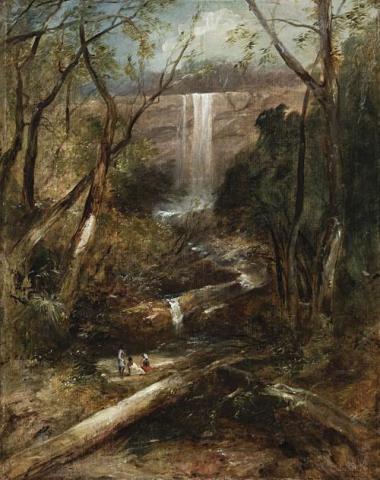WILLOUGHBY FALLS, NEW SOUTH WALES, c.1842
John Skinner Prout
oil on canvas
91.5 x 73.0 cm
Christie's, Australia, 7 October 1986, lot 271
The Dallhold Collection, Christie's, Melbourne, 28 July 1992, lot 44
Private collection, Perth
Skinner Prout in Australia 1840-1848, Tasmanian Museum and Art Gallery, 9 December 1986 – 1 February 1987, and touring to the Art Gallery of New South Wales, Sydney and National Library of Australia, Canberra, cat. 2
Prout, J.S., Prout's Dioramic Views of Australia, 1850, pp. 20–21
Brown, T. and Kolenberg, H., Skinner Prout in Australia 1840–1848, Tasmanian Museum and Art Gallery, Hobart, 1987, p. 35, cat. 2 (illus.)
De Bussy, D., The Alan Bond Collection of Australian Art, Dallhold Investments, Perth, 1990, p. 56
'Skinner Prout's taste for the picturesque (common among his British contemporaries), coupled with the spontaneity of his watercolour technique proved well-suited to the spacious Australian landscape and its intense cool light.
In contrast to other colonial artists, his view was fresh and modern. He was less interested in rendering scenes topographically or the depiction of important buildings, than in the expression of a lyrical vision of landscape. In fact Skinner Prout's compositional simplicity, economy, cool colouring, and masterly handling of the watercolour medium, his open simple foregrounds, especially in his Australian watercolours, places him far in advance of most of his colonial contemporaries.
As one of the artists of the loosely labelled 'Bristol School' of the 1820s and 1830s in England, Skinner Prout was an early adherent of the approach of sketching 'en plein air', or 'out of doors', an approach which eventually led to 'impressionism.' He was one of the first such artists in Australia, which is what one suspects made the more romantically inclined Conrad Martens suspiciously critical'
Skinner Prout's Australian works have an affinity with some of the most interesting of the French pre-impressionist watercolourists (who had an eye to England through Bonington) - Harpignies, Huet, Boudin and the Dutchman Jongkind - especially in his freshness and directness of approach...'1
Significantly, the present painting is closely related to a watercolour inscribed Willoughby Falls/ North Shore, Sydney in the Dixson Galleries of the State Library of New South Wales; an untitled version in the Mitchell Library; and another work dated 1842 from the Cowlishaw collection (sold Sotheby's, October 1984, lot 218). The Art Gallery of New South Wales also has a similar work with the descriptive title Bush landscape, with waterfall and an aborigine [sic.] stalking native animals, New South Wales. Notably, Prout later returned to the subject in subsequent publications - an engraving after Prout appears in E.C. Booth's Australia Illustrated, 1873 - 76; and descriptions of the scene are published in Prout's Dioramic Views of Australia, 1850, and An Illustrated Handbook of the Voyage to Australia and a Visit to the Goldfields, 1852.
1. Brown, T. and Kolenberg, H., Skinner Prout in Australia 1840-1848, Tasmanian Museum and Art Gallery, Hobart, 1987, p. 7
